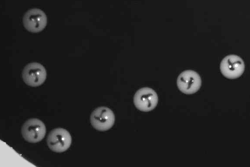Getting an Extra Bounce

Like a gymnast who runs toward a vaulting horse and then hurls herself skyward, a ball can, under certain conditions, rebound from a glancing impact with a surprisingly vertical trajectory. It’s a phenomenon that’s been observed but never fully explained–and at times even doubted. But now researchers report in the 8 October PRL that they have developed a theory that explains the phenomenon and have tested it with computer simulations. Their explanation–which hinges on the ball’s impact deforming the surface it hits–could help refine models of the flow of granular materials such as sand dunes, cement, and soil.

The coefficient of normal restitution compares the vertical component of the velocity of an object before and after it has bounced. Conventional wisdom says it’s less than one–that is, a ball can’t leave the ground moving faster than when it arrived, because that would require extra energy (in the case of the gymnast, her body creates energy). But since the early 1990s several research groups have reported experiments with oblique impacts in which they found what seemed to be absurd results: A hockey-puck-like disk glanced against a wall and then appeared to pop away with an increased perpendicular velocity [1] and a ceramic sphere rebounded off a softer surface with a noticeably more vertical trajectory [2].
“They first thought I was crazy!” says Michel Louge of Cornell University, who performed the sphere-bouncing experiment with student Michael Adams. But after carefully ruling out experimental error, he concluded that the ball must deform the surface in such a way that it changes the trajectory of the ball. In that way, he thought, some of the horizontal component of the velocity could be transferred to the vertical component. He wasn’t sure exactly how this would happen, although it was clear that the effect was limited to special situations. “My conjecture in the [experimental] paper was just that–a conjecture,” he says.
Now Hiroto Kuninaka and Hisao Hayakawa of Kyoto University in Japan report that they have simulated the small-scale interactions between a disk and an elastic surface that can lead to a greater-than-one coefficient of normal restitution. Their computer simulation calculates a coefficient of 1.3 when the disk strikes the surface at an angle of about 11 degrees; at that angle, their simulated ball rebounds at about 15 degrees. The simulation results resemble Louge’s experimental data, according to the authors.
The simulation allowed the team to see the virtual disk denting the surface when it hit at oblique angles. Bill Stronge of Cambridge University in England describes the indentation as a kind of ski jump, which redirects the sphere’s velocity skyward. Because of this phenomenon, the coefficient of normal restitution can be greater than one without breaking the laws of physics. “The point is that the target material is softer than the ball,” says Kuninaka.
But Stronge doubts that the impact could make as vertical a ski jump as the researchers’ model suggests. It may have some effect, he says, “but I think that it’s certainly not nearly as dramatic as they have portrayed.” Computer models of granular materials such as cement and soil must account accurately for the collisions between grains, which can be treated like collisions with walls. So the work could contribute to practical advances in industries that manage and transport these materials, says Louge–and add to the understanding of the physics of ball sports.
–Chelsea Wald
In 2006 Chelsea Wald was a science writing intern at APS. Now she is a freelance science writer in the Netherlands and the author of Pipe Dreams: The Urgent Global Quest to Transform the Toilet (Simon & Schuster, 2021).
References
- J. Calsamiglia, S. W. Kennedy, A. Chatterjee, A. Ruina, and J. T. Jenkins, “Anomalous Frictional Behavior in Collisions of Thin Disks,” J. Appl. Mech.66, 146 (1999).
- Michel Y. Louge and Michael E. Adams, “Anomalous behavior of normal kinematic restitution in the oblique impacts of a hard sphere on an elastoplastic plate,” Phys. Rev. E 65, 021303 (2002)


